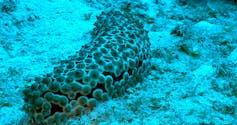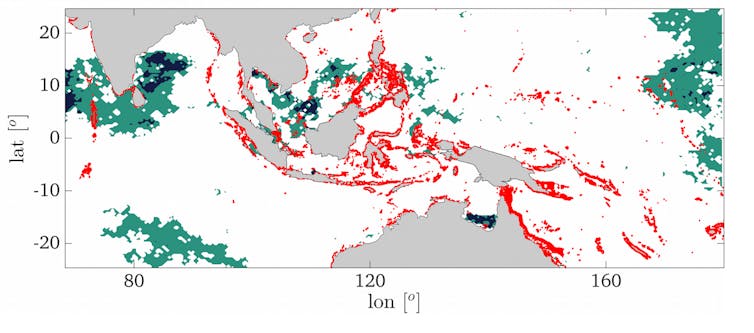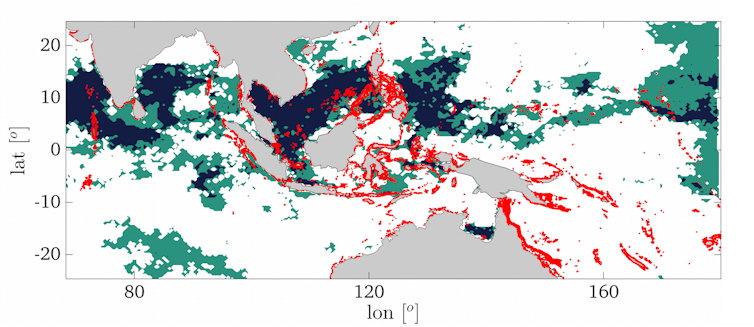The world’s coral reefs are like underwater cities, bustling with all kinds of fish and sea animals. Coral reefs cover less than 1% of the ocean, but they support an estimated 25% of all marine species, including many important fish species. The economic value of the services that these complex ecosystems provide is estimated at over US$3.4 billion yearly just in the U.S.
Today, rising ocean temperatures threaten many reefs’ survival. When ocean waters become too warm for too long, corals expel the colorful symbiotic algae, called zooxanthellae, that live in their tissues – a process called coral bleaching. These algae provide the corals with food, so bleached corals are vulnerable to starvation and disease and may die if the water does not cool quickly enough.
With global ocean heat at record levels, scientists have confirmed that a global coral bleaching event is underway. Since the beginning of 2023, corals have been dying in the Indian, Pacific and Atlantic oceans, both north and south of the equator.
The current bleaching event in the wider Caribbean region is longer and more severe than any previous bleaching episode recorded since the first global one in 1998. I study large-scale climate and ocean dynamics and am analyzing how biological connections between coral reefs – sometimes extending over great distances – may help reefs recover from heat stress.
Reef relationships
Given how quickly ocean temperatures are warming, scientists are working to develop response strategies. These include making corals more heat-tolerant; restoring damaged areas with healthy corals; relocating coral nurseries to cooler areas; breeding “super corals” that are more resistant to these stresses; and enhancing natural chemical signals and sound cues to attract larval corals and fish to damaged reefs.
Many species of fish found on coral reefs play valuable roles in keeping these communities healthy. For example, seaweeds compete with corals for space and light, and often will take over reefs after bleaching episodes.
Corals remain healthier and recover faster if they are surrounded by fish that eat different types of seaweed, such as parrotfish, surgeonfish and rabbitfish. Reflecting their role, these species often are referred to collectively as grazers.
Sea cucumbers – leathery bottom-dwellers, distantly related to starfish and urchins – also are important reef partners. They feed on bacteria and other organic materials in ocean sediments, cleaning up the area around reefs.

My Georgia Tech colleague Mark Hay recently published a study which showed that removing sea cucumbers from reef communities led to an increase in organic waste materials and a 15-fold rise in coral deaths. Protecting sea cucumbers, which are overharvested as a food source, could help keep coral reefs healthy.
The role of ocean connectivity
Coral reefs are not isolated outposts. When fish and corals spawn, they release millions of larvae that drift on currents and are exchanged across reefs through mixing and transport processes. These exchanges make up the connectivity of coral reefs.
Some reefs supply larvae to many others. Other reefs are more isolated, so scientists may need to artificially introduce larvae to help the reefs recover from bleaching and other threats.
Research shows that well-connected reefs recover faster from stresses like bleaching. Receiving plentiful supplies of coral and fish larvae, transported by ocean currents from far away, helps to restore bleached areas and maintain diverse reef communities. Preserving this connectivity is key for reef conservation.
But measuring connectivity is time-consuming and expensive. Researchers collect coral samples from reefs that may be connected and analyze the corals’ DNA to reconstruct their genetic history. This yields a picture of how interrelated different populations are.
We also use computer models to simulate ocean currents carrying virtual larvae from their release points to the locations where they settle. But currents aren’t fixed in place like highways: Their strength and direction change over time, depending on the season and the year. Studying reef connectivity requires carrying out multiyear model simulations covering small areas in fine detail, which involves a lot of computation.


Insights from machine learning
Now, machine learning offers a new way to analyze reef connections. This subfield of artificial intelligence enables computers to learn tasks or associations without explicitly being directed. Instead, they use algorithms to tackle various tasks.
My research group has developed a tool that takes information about ocean currents, derived from satellite data; generates a network of ecoregions, or areas where ecosystems are generally similar; and calculates their connectivity over the past 30 to 40 years. We then identify better-connected reefs using PageRank centrality – the algorithm that Google developed to measure the popularity of web pages.
Once we have defined a network of ecoregions, it is possible to determine how “popular” – that is, connected – known reefs are. And we can verify that our algorithms are working well by seeing whether “popular” reef communities contain more diverse and healthy coral populations.
We have found that in Southeast Asia’s Coral Triangle – the biggest biodiversity hot spot on Earth – periodic shifts between the El Niño and La Niña climate patterns promote biodiversity, and likely have done so for the past 5 million to 7 million years. Connectivity during El Niño events is very different from that during La Niñas, because ocean currents are different. This dynamic aids reefs by ensuring that they receive larvae from many different places in different years.
Understanding which coral and environmental traits helps make reefs resilient, and coupling this information with connectivity networks opens new avenues for helping corals to survive a bit longer. Together, these approaches indicate how and where to prioritize monitoring and restoration efforts.
In the long run, the only ways to stop coral die-offs and protect reef habitats that support so much sea life are limiting water pollution and curbing climate change. But more localized actions that make reefs healthier can buy them some time, and perhaps make them more resilient to ocean warming.

